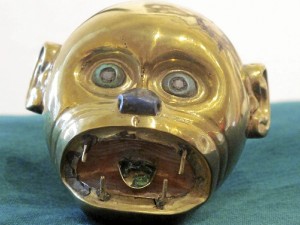 The New Mexico History Museum returned a gold pendant shaped like a monkey’s head from the pre-Columbian Moche culture (ca. 100-800 A.D.) to Peruvian embassy officials in a ceremony in Washington, D.C. on Thursday. The monkey is 1.75 inches high by 2.25 inches wide, with turquoise and shell eyes, a turquoise tongue, a lapis lazuli nose and a ball inside that makes the head rattle when you shake it. It’s a superb example of Moche workmanship, probably worn on a necklace by royalty or other august personages.
The New Mexico History Museum returned a gold pendant shaped like a monkey’s head from the pre-Columbian Moche culture (ca. 100-800 A.D.) to Peruvian embassy officials in a ceremony in Washington, D.C. on Thursday. The monkey is 1.75 inches high by 2.25 inches wide, with turquoise and shell eyes, a turquoise tongue, a lapis lazuli nose and a ball inside that makes the head rattle when you shake it. It’s a superb example of Moche workmanship, probably worn on a necklace by royalty or other august personages.
So superb, in fact, that Peruvian archaeologist Walter Alva, who along with his wife Susana Meneses discovered the spectacular Moche Lord of Sipán tomb in 1987, thought it looked a little too familiar when he saw it on display at the Art of Ancient America exhibit in the Palace of the Governors in Santa Fe in 1998. The Sipán tomb, which Alva had discovered intact, was looted shortly after its discovery by brothers Juan, Samuel, Emilio, and Ernil Bernal. They dragged dozens of sacks full of gold from the tomb to their house, buried the loot in their backyard and then sold it all off to eager collectors who, as usual, asked no questions.
The monkey was purchased by collector John Bourne in the late 80s along with a number of other Moche artifacts for $120,000. He donated it to the New Mexico History Museum in 1995. He also loaned two Moche ear spools and a gold rattle for the 1998 exhibit, although he retained ownership of those items. Bourne denied that the monkey’s head (or the other pieces) came from Sipán. He claimed instead that it came from La Mina, another Moche archaeological site in north Peru which was looted in 1988. This is no rebuttal to the charge that Bourne bought stolen goods, of course, since even if it did come from La Mina its theft and export were just as illegal as they would have been had the artifact come from the more famous Sipán site. As a legal maneuver, however, it was damned effective because establishing which site an artifact was stolen from is a basic requirement of making the case in a court of law.
The Peruvian government officially requested that the artifact be repatriated since it had been looted from the Sipán archaeological site and exported against Peruvian law. Alva went directly to the FBI, which opened an investigation in September of 1998. Citing the National Stolen Property Act, the FBI seized the monkey, ear spools and rattle, but since experts disagreed on whether they had been stolen from Sipán (as Alva and Peru alleged) or from La Mina (as Bourne claimed), in 2000 the U.S. Attorney General’s office in Albuquerque declined to prosecute. The pieces went back to the museum where they remained on display until 2008 and then the loaned objects were returned to Bourne.
That’s where things stood until this Spring. In May of this year, Peru wrote to Attorney General Eric Holder asking the Department of Justice to look into the situation. In October, the Board of Regents of the Museum of New Mexico voted to return the monkey head to Peru.
Pet peeve time. U.S. Attorney Charles M. Oberly III made the following statement about the return of the gold monkey:
“This repatriation is the result of the joint efforts of this office, the FBI Art Crime Team, the Department of Justice Office of International Affairs, the New Mexico Attorney General’s Office and the Museum of New Mexico. I commend all parties for their efforts in producing this positive outcome. In particular, I commend the Museum of New Mexico for its selfless and noble action in returning this invaluable artifact to Peru. Artifacts like this Moche monkey head represent the history not only of the source country, in this case Peru, but the history of all mankind. We hope that this repatriation will help repair at least some of the damage caused by the looting of Moche sites.”
What is with the legal authorities kissing the ass of museums and collectors who finally return the stolen goods they refused to cough up for decades? The Museum of New Mexico was not selfless and noble in returning this invaluable artifact they KNEW was stolen all along.